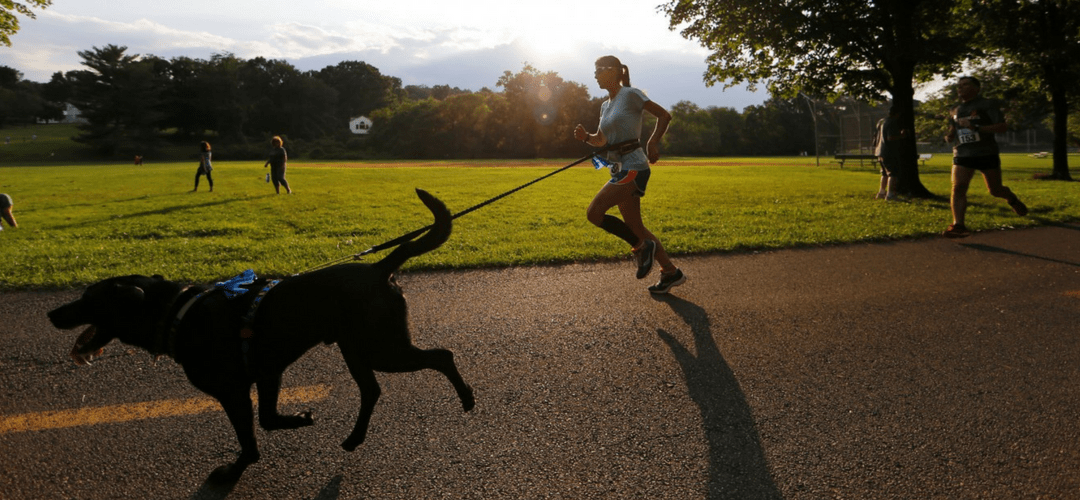As I’m sure you hear us say over and over again, this area is such a beautiful natural playground. Well, it is. We are in the shadow of the Cascade Mountain range with trails all around us so we spend a lot of time outdoors, and many of us spend time with our canine companions. Our dogs run with us, hike with us, and some even kayak and canoe with us. Big or small, dogs love spending time with us…we are their people. But if you’ve never run with your dog, or have a new dog, our running ambassador Laura from This Runner’s Recipes has a few tips for us on how to run with dogs.
LACE UP TIPS FROM LAURA
Running may be a solo sport, but you can join up with running buddies to make those miles more fun. The companionship keeps you accountable when you don’t feel motivated and helps pass the miles by more quickly. Your best running buddy doesn’t even have to be a person – he or she could be your four-legged best friend.
Dogs are energetic, loyal, and happy – the qualities that you want in a running buddy. Your pooch will benefit from the exercise, both in terms of improving physical health and releasing physical energy.
Get the Right Gear
Whether I am running with my Labrador/Cattle Dog mix or my puggle, I make sure that the dog is safely tethered to me. Both dogs wear a harness, so that the anchor point of the leash is around their midsection rather than their neck. I use a hands-free running leash, which anchors around my waist so that the leash does not hinder my arm swing or affect my running form.
Be sure to follow leash laws in your city and consider your dog’s safety and the safety of others above all else. If you are running along a road, running on a multi-use path, or running through a populated area, always leash your dog.
Start with Short, Easy Runs
You didn’t start running hour-long runs right away – and neither should your dog. Your dog needs time to adapt both his aerobic system and his muscular-skeletal system. Begin with just a slow mile at a time – maybe you take your dog on a cool down jog after your main workout. Puppies under nine months old should start with short, gentle hikes. You may choose to use run-walk intervals to ease your dog into running as well.
How you progress depends on your dog. Very athletic dogs may progress more quickly than smaller breeds. For example, my puggle took longer to progress in his distance than my Labrador/Cattle Dog mix, who quickly adapted to running 7 miles or longer.

Know the Breed’s Limits
Your dog’s breed plays a role in their athletic ability. Very small breeds, such as Chihuahuas and Yorkies, may be better suited for walks. Breeds with short snouts, such as pugs and bulldogs, may have trouble breathing while running. Meanwhile, larger breeds meant for herding, hunting, and retrieving are made for running. These types of dogs include Labradors, Golden Retrievers, Australian Cattle Dogs, Rhodesian Ridgebacks, Vizslas, and German Shepherds. Some of these more athletic breeds may be able to run 10 miles or more with the proper progression of training.
Practice Training Cues
Properly managing your dog on the run starts with good training and it can be aided by training cues. Just like distance and pace, training and repetition will reinforce these training cues and build good behavior.
Useful training cues include:
- “Run” to tell your dog it’s time to start the run.
- “Sidewalk” to cue your dog to hop up on the sidewalk and out of the way of vehicles.
- “Street” for when your dog should move off the sidewalk and into the side of the street.
- “Cross” for when you and your dog are crossing a street.
- “Turn Left” and “Turn Right” to direct your dog in which direction to run.
- “Turn Around” for when you are running an out-and-back route.
- “Easy” for when your dog is pulling on the leash or running too fast.
- “Leave It” for when your dog sees a squirrel, duck, or other distraction.
- “Stop” for when you want your dog to stop running.
Running with your dog takes practice and patience, but it pays off in the reward of a running buddy and a healthy, happy pet.
For many of us our lives would not be complete without our pets. They give us love, joy, entertainment and comfort and incorporating them into our lifestyles is a natural goal. To all the pet owners, to all the pets who are like family, you remind us to love unconditionally and that is Wholesome to the Core.

A few Rainier Fruit employees enjoying the outdoors with their dogs
Want to treat your dog to some homemade treats? Check out our post on how to make natural dog treats with apples and blueberries.
“Pets are not our whole life, but they make our lives whole.” – Unknown

